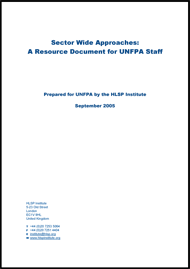This book aims to familiarise you with Sector Wide Approaches (SWAps) and to help in preparing you to face the challenges they pose. It is designed in an accessible way in order to be useful to both those with no prior knowledge of SWAps, and to those who have already operated within a SWAp environment and wish to build on existing knowledge. The materials draw mostly on health sector experiences and examples, and are based on work prepared by the HLSP Institute for UNFPA.
Who is it for?
This tool is mainly intended for staff of donor agencies involved in the design or implementation of sector programmes. It will also be useful to officials in partner governments, consultants, and anyone wishing to learn how to design, manage and implement sector programmes.
What is covered?
The book is structured in 5 modules, followed by a list of key references:
- Module 1 - Maps out what SWAps are, how they can help accelerate progress towards health targets, explains their benefits and the key implications of this new way of working.
- Module 2 - Looks at what they are intended to achieve, as well as outlining some of the potential stumbling blocks which will need to be overcome.
- Module 3 - Provides a broad introduction to the core components of a SWAp, considers the future beyond SWAps, and the potential role for other aid instruments to further improve aid effectiveness.
- Module 4 - Looks at the individual components of a SWAp in greater detail.
- Module 5: Looks at some key issues that may emerge in a SWAps context: the links between SWAps and PRSPs; how to integrate (existing) projects into sector programmes; the relationship between SWAps and decentralisation; and some of the issues raised by Global Health Partnerships.
- Reference materials



